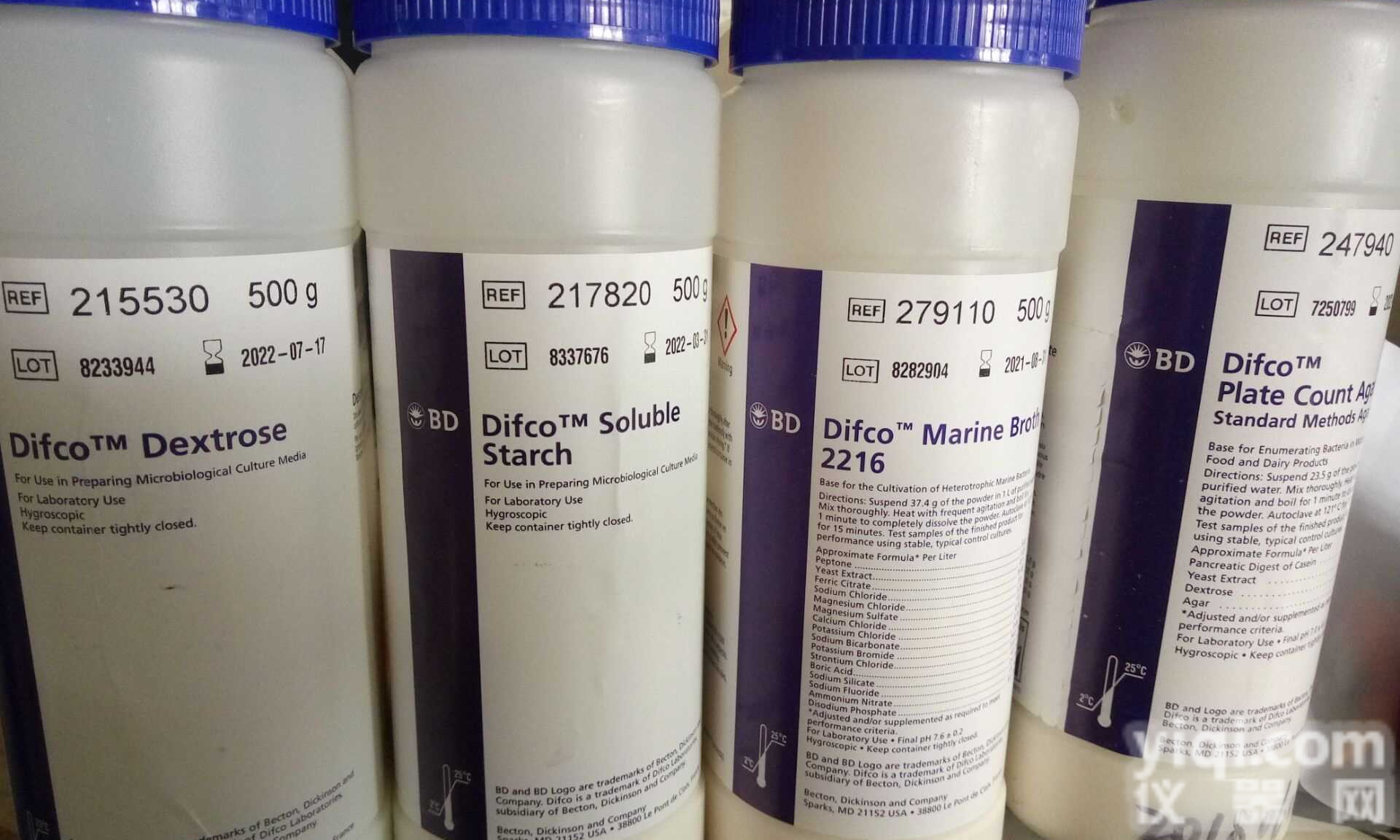分离大肠杆菌O157
a selective and differential medium for the detection of Escherichia coli O157 | Typical Formula* | gm/litre |
| Peptone | 20.0 |
| Sorbitol | 10.0 |
| Bile salts No.3 | 1.5 |
| Sodium chloride | 5.0 |
| Neutral red | 0.03 |
| Crystal violet | 0.001 |
| Agar | 15.0 |
| pH 7.1 ± 0.2 @ 25°C | |
CEFIXIME-TELLURITE SUPPLEMENT
Code: SR0172
a freeze-dried supplement for use with Sorbitol MacConkey Agar for the selective isolation of Escherichia coli O157
| Vial contents | per vial | per litre |
| Potassium tellurite | 1.25mg | 2.5mg |
| Cefixime | 0.025mg | 0.05mg |
Directions
Suspend 51.5g in 1 litre of distilled water. Bring to the boil to dissolve completely. Sterilise by autoclaving at 121°C for 15 minutes. Allow to cool to 50°C. Pour into sterile Petri dishes.
If required, reconstitue one vial of C-T supplement per 500ml medium, according to instruction in the product leaflet. Aseptically add this to to cooled medium before pouring into sterile Petri dishes
Description
Escherichia coli O157 is recognised as a cause of haemorrhagic colitis, an illness characterised by bloody diarrhoea and severe abdominal pain, and haemolytic uraemic syndrome (HUS)1, 2, 3, 4, 5, and as such, it a significant human pathogen.
Sorbitol MacConkey Agar is recommended for the isolation of pathogenic E. coli O157. The formulation, based on that described by Rappaport and Henig6, is identical to MacConkey Agar No.3, except that lactose has been replaced with sorbitol. E.coli O157 does not ferment sorbitol and, therefore, produces colourless colonies. In contrast, most E. coli strains ferment sorbitol and form pink colonies. The efficiency of Sorbitol MacConkey Agar has been confirmed by March and Ratnam7. These workers reported a sensitivity of and a specificity of 85%, and recommended the medium as a simple, inexpensive, rapid and reliable means of screening for E. coli O157.
Chapman and co-workers8 added cefixime and potassium tellurite to Sorbitol MacConkey Agar to improve the selectivity of the medium. The level of potassium tellurite selects serogroup O157 from other E. coli serogroups and inhibits Providencia and Aeromonas species. Cefixime is inhibitory to Proteus spp.
The use of cefixime and tellurite in Sorbitol MacConkey Agar for isolation of E. coli O157:H7 is described in the FDA Bacteriological Analytical Manual 9.
Technique
1. Make up the agar according to the directions and pour into plates. If necessary dry the surface of the agar.
2. Inoculate the plates with a suspension of the test substance (food, faeces, etc) to produce separated colonies.
3. Incubate at 35°C for 24 hours. Doyle and Schoeni 10 reported that 35-37°C is the optimal temperature for growth of Escherichia coli O157. At 44-45.5°C growth is poor, even after 48 hours incubation.
Delay in reading plates beyond 24 hours should be avoided because the colour intensity of sorbitol-fermenting colonies fades, reducing the contrast with non-fermenting colonies. Other Gram-negative organisms including Pseudomonas, Proteus and Klebsiella species are able to grow on Sorbitol MacConkey Agar but may generally be differentiated by the appearance of their colonies.
A diagnostic reagent Escherichia coli O157 latex test (DR0620) is available so that instant confirmatory tests can be made from suspicious colonies.
Storage conditions and Shelf life
Dehydrated Sorbitol MaConkey Agar must be stored tightly capped in the original container at 10-30ºC.
Cefixime-Tellurite Supplement (SR0172) should be stored in the dark at temperatures below 0°C.
Oxoid Sorbitol MacConkey and Cefixime Tellurite Sorbitol MacConkey plates should be stored in the original packaging, at the temperature stated on the pack or product specification, and protected from direct light. When stored as directed, the unopened product will remain stable until the expiry date on the label.
Locally prepared media can be stored for up to 2 weeks when made from CM0813 and SR0172 according to the manufacturer’s instructions and stored at 2-8ºC, out of direct sunlight and protected from dessication. A longer shelf life may be attainable, but should be validated under the relevant, local manufacturing and storage conditions.
Appearance
Dehydrated medium: Straw/pink coloured, free-flowing powder
Prepared medium: Dark red gel
* Adjusted as required to meet performance standards
 山梨醇麦康凯琼脂(Sorbitol MacConkey Agar)
山梨醇麦康凯琼脂(Sorbitol MacConkey Agar)
 山梨醇麦康凯琼脂(Sorbitol MacConkey Agar)
山梨醇麦康凯琼脂(Sorbitol MacConkey Agar)
 山梨醇麦康凯琼脂(Sorbitol MacConkey Agar)
山梨醇麦康凯琼脂(Sorbitol MacConkey Agar)
 山梨醇麦康凯琼脂(Sorbitol MacConkey Agar)
山梨醇麦康凯琼脂(Sorbitol MacConkey Agar)
 山梨醇麦康凯琼脂(Sorbitol MacConkey Agar)
山梨醇麦康凯琼脂(Sorbitol MacConkey Agar)
 山梨醇麦康凯琼脂
Sorbitol MacConkey Agar
山梨醇麦康凯琼脂
Sorbitol MacConkey Agar
 HiCrome™ 麦康凯山梨醇琼脂琼脂 83339-50.2G-F
HiCrome™ 麦康凯山梨醇琼脂琼脂 83339-50.2G-F
 麦康凯山梨醇琼脂
麦康凯山梨醇琼脂
 麦康凯山梨醇琼脂
麦康凯山梨醇琼脂
 美国BD DIFCO279100麦康凯山梨醇琼脂
美国BD DIFCO279100麦康凯山梨醇琼脂
 麦康凯山梨醇琼脂
麦康凯山梨醇琼脂
 麦康凯山梨醇琼脂,MacConkey Sorbitol Agar
麦康凯山梨醇琼脂,MacConkey Sorbitol Agar